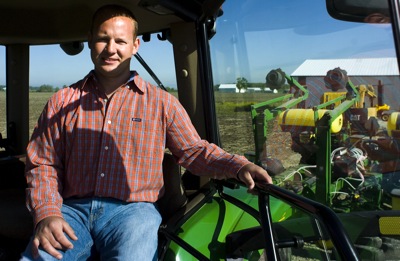Friday, May 20th, 2011
Farmers' optimism as damp as fields
By Nancy Allen

Photo by Mark Pummell/The Daily Standard
Celina area farmer Seth Kohnen sits inside a tractor on his farm. He's got everything ready to go - seed, fertilizer, chemicals - but can't plant because of almost constant rain.
Today's sunshine is a rare sight and its presence will do little to brighten area farmers' outlook for the growing season.
Ongoing rainy, cool weather continues to delay planting and poses a serious threat to corn and soybean crops locally and statewide.
Celina area farmer Dennis Howick has invested thousands of dollars in seed, fertilizer and pesticide. It's all sitting in his barn until the rain stops and the ground dries.
"You don't want to know," Howick said when asked how he felt about the situation. "Nobody's in a good mood and everybody's nervous."
Howick said 1981 was almost as bad, but even then he still had about half his corn in the ground by this time. As of today, he's planted nothing.
His situation is similar to hundreds of others in Mercer and Auglaize counties.
One percent of corn in Mercer County has been planted and no soybeans, said Mercer County Farm Service Agency Executive Director Chris Gibbs. In a typical year, 80 percent of the corn and 70 percent of the soybeans would be in. Auglaize County is much the same, said OSU Extension educator John Smith, where "just a bit" of corn is in and no soybeans.
"It appears we're going to be planting much of this crop in June which will lend itself to significant yield losses, particularly for corn," Gibbs said.
USDA statistics for Ohio as of May 15 (http://www.nass.usda.gov/) show only 7 percent of the state's corn has been planted, 76 percent behind last year and 63 percent behind the five-year average. Just three percent of the state's soybeans are planted, compared to 44 percent last year and the five-year average.
Ohio farmers stand to lose 132 million bushels of corn at a value of $927 million, according to WeatherBill, a weather/crop insurance firm that pays farmers for losses because of weather damage. If wet weather continues, the loss could rise to 239 million bushels of corn at a value of $1.67 billion.
Late planted crops can be more susceptible to insect damage, early frost and there's an increase in the likelihood plants will be less mature and have higher moisture levels, Gibbs continued. Excess grain moisture increases drying costs.
The delay will cause significant stress, particularly for dairy farmers. The shortened planting window will compress time for hay cutting, hauling manure and planting. Add that to daily milking and feeding chores and that's a lot of work, Gibbs said.
Later and reduced cuttings of hay, which dairy farmers feed their livestock, also hurt, he said. Later planted corn should still be usable for silage.
Gibbs said his office is getting ready to start taking USDA program applications due to crop losses caused by the weather.
Damp conditions also could make wheat more susceptible to wheat scab. Wheat is allowed to have a certain amount of the mold disease, but if it goes too high, the price farmers get at the elevator drops. The mold produces a toxin which can make wheat unusable for human food and animal feed.
"If it's humid and warm, you have the possibility of head scab which causes vomotoxin," Smith said. "It if stays cool, that will deter a lot of head scab."
Seth Kohnen, who farms 2,500 acres northwest of Celina with his dad, Ron, and neighbor Gary Siebert, said he's worried, but there's not much he can do. Today and Saturday look to be rain free, he said, but Sunday through Wednesday has a chance of rain every day.
"It's not like we got flooded out, but it just stays wet enough that you can't do anything," he said.
If it gets into June, he may return his corn seed in exchange for a quicker maturing hybrid and plant that instead, or he may switch his corn acres to soybeans. It's still too early to make that call, but it's in the back of his mind, he said.
Research suggests that the maximum potential for corn yields starts to decrease if it's planted after May 10. Farmers can lose about a bushel per acre per day after that date, said Jim Hoorman, Mercer County OSU Extension educator. Farmers can plant soybeans into late May with little yield reductions, he added.
All any farmer can do now is wait until the rain stops and plan accordingly.
"Hopefully when it gets to that point, we'll go at it as hard as we can," he said. "Then all you can do is do the best job you can."



